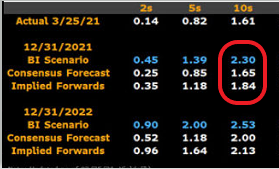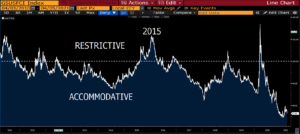2.30% 10 Year Treasury?
Our kids are too old to enjoy Easter Egg hunts anymore. Plus, they sleep too late. It feels weird to go looking for Easter eggs at 3pm with 5 kids, some of whom are over 6’ tall and some of whom can legally drink. But my wife is a sucker for tradition, clinging to their childhood.
We decided to mix it up this year and do a flashlight Easter Egg hunt Saturday night after it got dark. Because our kids have no concept of money (my biggest of many failings as a parent), we decided to switch it up this year. We put sticky notes inside the plastic eggs with things like, “Assign chore to sibling,” or “pick dinner” or “make someone tell you a dad joke.”
Best of all, they could trade. After they found the eggs, we huddled around the kitchen table and watched the action. Our 20 year old daughter had no need for “1 Pack of Pokeman cards”, so she traded with our 13 year old boy in exchange for, “Dancing in the kitchen with mom.”
This mini-trading floor action provided a glimpse into what each of them values the most. One daughter – time with us. The middle son – getting out of chores. The eldest son – cash (he sold his to his siblings that do a better job of saving money and he has a girlfriend). The youngest – Pokeman cards.
It also reinforced the notion that my wife and I are like the Fed – providing so much accommodation as to devalue currency. A sticky note that says, “$1” means nothing since they don’t pay for anything themselves anyway. Instead, we now are both paying for everything AND providing effort. The 13 year old, never a fan of delayed gratification, immediately cashed in his, “ColdStone run” last night at 9:30pm, because nothing says Happy Easter like ice cream mixed with an endless supply of chocolates.
Most importantly, it helped identify what my wife values. I had snuck in a “tattoo of your choosing” and the 17 year old pulled it. Let’s see how much she’ll pay to buy that one off him.
Last Week This Morning
- 10 Year Treasury back up to 1.72%
- German bund at -0.33%
- 2 Year Treasury unchanged at 0.186%
- LIBOR at 0.11%
- SOFR at 0.01%
- The economy added 916k jobs vs a forecasted 660k gain
- Average Hourly Earnings fell 0.1% (lack of inflation)
- The unemployment rate fell from 6.2% to 6.0%
- The U-6 (“real” unemployment) fell from 11.1% to 10.7%
- Consumer Confidence is at a post-pandemic high
- US Manufacturing Index hit a 37 year high
- Biden claimed his infrastructure bill will create 19mm jobs over the decade, but the report he cited actually concluded that more than 16mm of those jobs would be created naturally anyway.
- One of the greatest coaches of all-time retired. Roy Williams said, “I no longer feel that I am the right man for the job.” This is simply not true. Class, integrity, and brilliance will always be in style. It remains to be seen, however, how Coach plans on using all those timeouts he hoarded over the years.
Jobs
Throwing out last summer’s screwy numbers, March’s job gains were the strongest ever by a wide margin. The economy added 916k jobs last month. The previous high was 540k in May 2010. The second highest was less than 400k. It was an incredibly strong number.
Key beneficiaries:
- Leisure and Hospitality added 280k
- Construction added 110k, following last month’s weather-impacted 56k loss
- Professional and business services added 66k
- Manufacturing added 53k
- Government workers up 136k
While the 10 Year Treasury moved up a few basis points, the most dramatic impact was on the front end of the curve where the market now has a hike priced in 2022.
As a result, interest rate cap prices have jumped. We sent out a cap pricing update on March 13th, letting everyone know pricing was up. That pricing is already stale. We’ve seen cap prices up 50% in the past two weeks.
Infrastructure and the 10 Year Treasury
On Wednesday, Biden unveiled a $2.25T infrastructure bill. The social program aspects of the bill will be released in later April, expected to come in around $1T. All told, that’s more than $3T, on top of the $1.9T, on top of the $900B in December…spend more faster. Dems are now referring to it as the “New New Deal,” or as I like to call it, “New New Terrible Name”.
Biden expects to pay for the bills primarily through increasing corporate tax rates from 21% to 28%. From a rates perspective, this means the bill should not apply a lot of upward pressure because we won’t need to fund it through Treasury supply. As that calculus changes through negotiations, expect a corresponding reaction in rates.
Bloomberg Rates has officially changed its year-end forecast for the 10 Year Treasury to 2.30%.

Bloomberg’s fair value model puts the 10T at 3.07% by year end 2022.
As data comes in strong, like Friday’s job report, the market will continue to be nervous about tapering. The consensus forecast for US GDP this year is 6.5%, with some like Goldman calling for 8%.
Rising rates are only mildly tightening financial conditions thus far. Notice the slight pop in the bottom right hand of the graph. Then consider we are still near all-time accommodative position despite the recent spike in yields.

Week Ahead
The Masters returns sans Tiger, which is another way of saying I probably won’t watch.
March Madness concludes, with Baylor upsetting Gonzaga and ruining their perfect season.
Very little economic data, so keep an eye on developments on the Spend More Faster bill.




